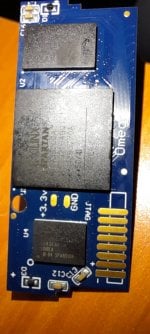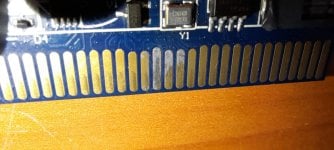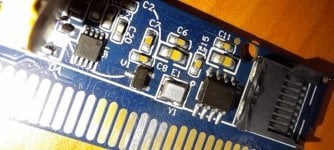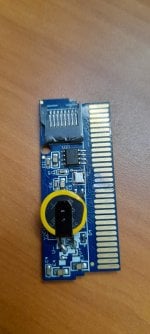For anyone arriving at this thread looking for answers regarding their non booting (no Nintendo logo at start) EZ-Flash Omega.
If replacing the crystal oscillator according to the "basic repair guide" (mentioned above) doesn't repair it then maybe the EEPROM (U3) chip is malfunctioning. In this case it was a bad "Puya P25D40H".
I repaired it by getting a new EEPROM, in this case a "M25P40" by "ST" I chose this one because my two Omegas had it.
It was flashed with a BIN file created with offsets from a known working Omega EEPROM dump and offsets from the bad EEPROM.
It appeard to me that each EEPROM dump became unique after offset 0x00030000.
I used a hex editor (HxD) and pasted everything from 0x0 -> 0x0002FFFF from the good Omega and then the rest from 0x00030000 and beyond from the bad Omega and saved as new 512KB .BIN file.
For the dumping and flashing:
The EEPROM was de-soldered from the Omega and soldered on to a socket adapter board connected on top of a CH341B programmer (check Amazon, eBay, Aliexpress) and was used together with NeoProgammer.
Attached to this post you can download the .BIN file with the first offsets from the good Omega at FW and Kernel 1.09.
You'll also need the ezkernel.bin v1.09 in the root of your SDcard if your Omega isn't updated to 1.09 since it will want to update if it detects and older version.
One give away that the EEPROM was failing was that different CRC codes were calculated each time NeoProgrammer read it.
The more obvious one was that the data was being changed each time it was flashed and couldn't be verified afterwards.
This wasn't an issue with the new EEPROM.
Maybe the @EZ-Flash2 team could advice us what to do in the case that the EEPROM is completley corrupt and there's nothing to salvage or maybe if possible divorce the EEPROM from the rest of the cart in their next update?
Good luck!
-edit for clarification
Hello my brother,
Maybe you can help me, I changed the U3 chip and reprogrammed it. Previously I had already made the change of the Crystal.
But when I finished changing the U3 chip and tested it, I was surprised that this happened:
1. I insert the cartridge in the GBA or GBA SP console, in both.
2. I turn on the console, and it doesn't turn on at all with the cartridge inside.
3. If I remove the cartridge, it turns on without any problem.
I have checked that I could have short and I have nothing, the U3 chip I programmed it well and even tried with another new chip the M25P40 programmed and soldered it also to test and same behavior, the consoles do not turn on with the cartridge inside.
Do you think I can check something else? I comment that before changing the U3 chip if the consoles turned on with the cartridge inside, but did not pass the Nintendo Logo.






